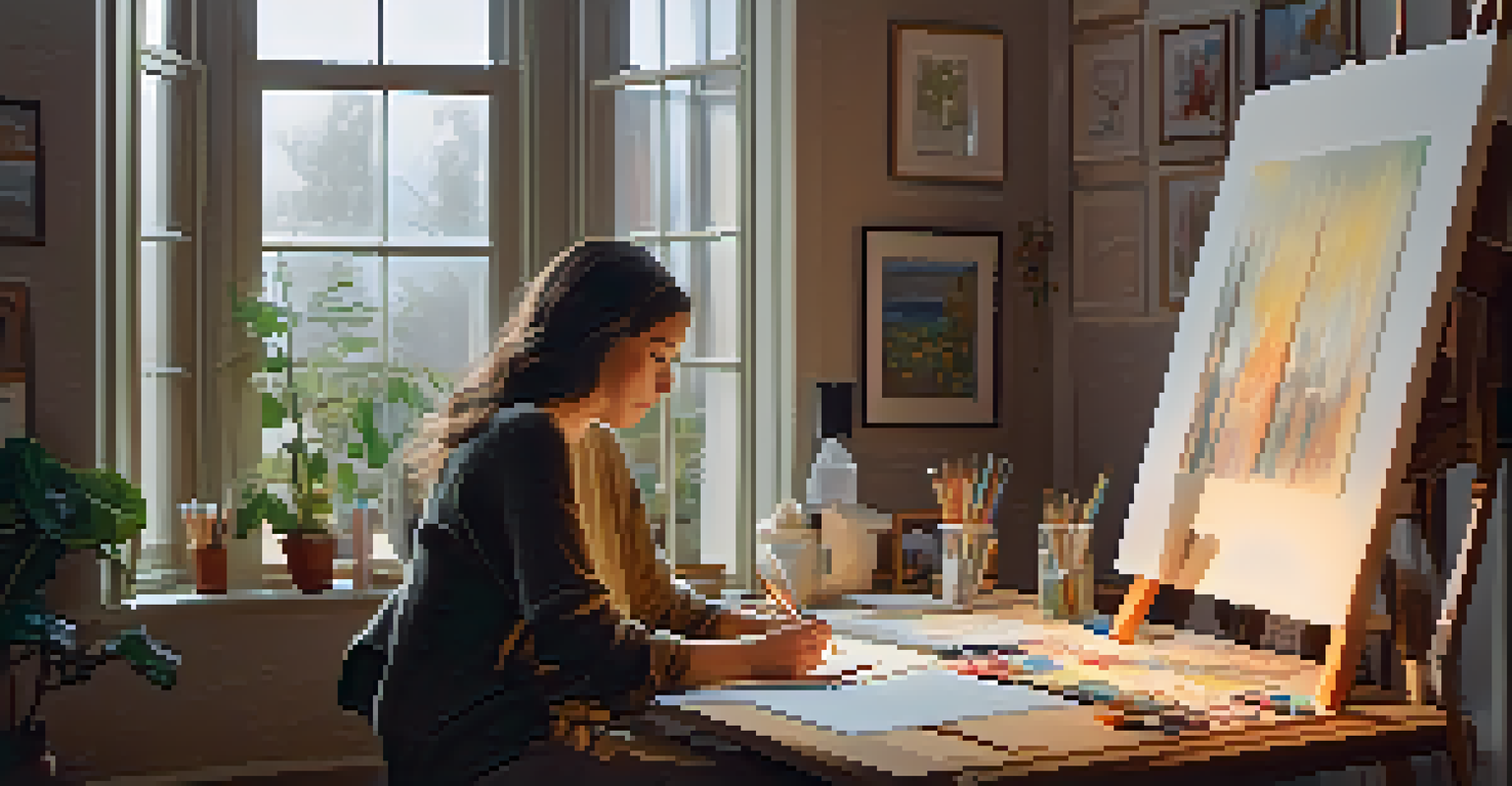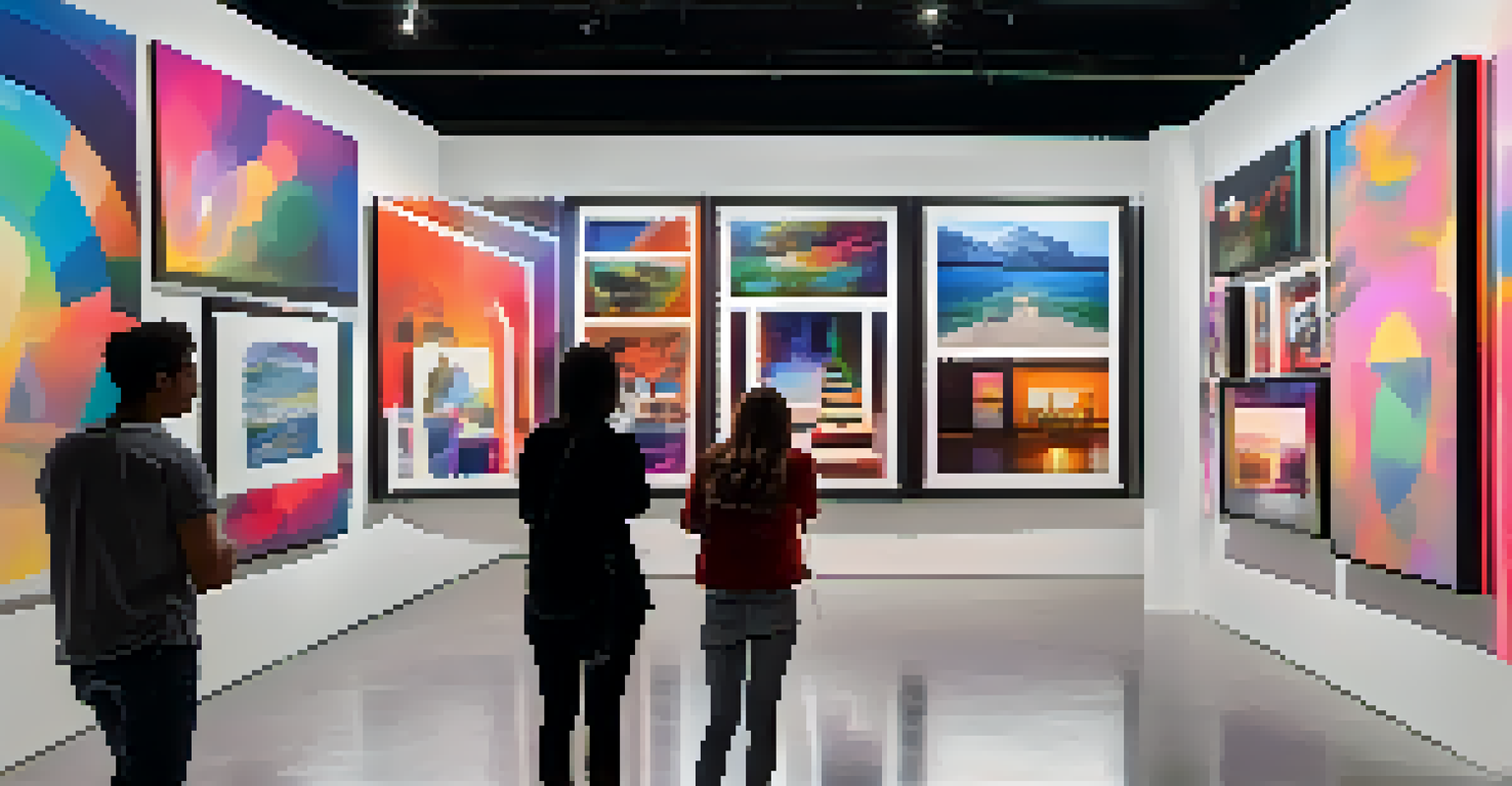Exploring the Role of Art in Shaping Personal Memories

Art as a Catalyst for Memory Recall
Art has a unique ability to evoke memories, often transporting us back to specific moments in time. When we encounter a painting, a song, or even a piece of literature, it can trigger a flood of recollections from our past. For instance, the scent of a particular flower in a painting might remind us of a childhood garden, bringing back vivid images and emotions associated with that place.
Art is the most beautiful of all lies.
This connection between art and memory illustrates how deeply intertwined our experiences are with creative expressions. Artists often draw inspiration from their own life stories, embedding personal memories into their work, which in turn resonates with viewers. As we engage with these pieces, we might find ourselves reflecting on our lives and experiences, leading to a rich tapestry of shared human emotions.
Moreover, engaging with art can foster a sense of nostalgia, a bittersweet longing for the past. This feeling allows us to appreciate our personal journeys, as we recognize the milestones that have shaped who we are today. Thus, art becomes not just a medium of expression but also a powerful tool for memory exploration.
The Emotional Resonance of Artistic Expression
Art is a channel for emotional expression, allowing both artists and viewers to communicate feelings that words often fail to capture. When we look at a piece of art that speaks to us, it can resonate on a personal level, stirring emotions tied to our own memories. This shared emotional experience can create a deep sense of connection with the artwork and its creator.

Consider a poignant song that reminds you of a significant life event, like a wedding or a loss. The melodies and lyrics can encapsulate feelings that encapsulate those moments, making them even more memorable. In this way, art not only reflects our experiences but also amplifies their emotional weight, making them more vivid and alive in our minds.
Art Evokes Powerful Memories
Art has the unique ability to trigger vivid memories and emotions, connecting us to our past experiences.
Furthermore, the act of creating art can be therapeutic, allowing individuals to process their memories and emotions. Many artists use their craft as a means of coping with experiences, transforming pain into beauty. This emotional release not only aids in personal healing but also contributes to a collective understanding of shared human experiences.
Art and Memory Formation in Childhood
The role of art in shaping memories is particularly significant during childhood. Young children often engage with art as a form of play, exploring colors and shapes that help them make sense of the world. These formative experiences not only foster creativity but also lay the groundwork for how they will remember their early years.
Every artist dips his brush in his own soul, and paints his own nature into his pictures.
For instance, a child's first finger painting might be a vivid memory that ties back to feelings of joy and exploration. As they grow, these early artistic interactions can enhance cognitive development, aiding in memory retention and recall. This connection between art and memory formation illustrates how creativity is integral to a child's emotional and intellectual growth.
Involving children in art activities can also strengthen family bonds, creating shared memories that last a lifetime. Whether it's a family art project or a visit to a museum, these experiences can cultivate a love for art and an appreciation for the memories it can conjure later in life.
The Therapeutic Effects of Art on Memory
Art therapy has emerged as a powerful tool for individuals looking to process memories and emotions. Through creative expression, individuals can explore traumatic or significant life events in a safe and supportive environment. This therapeutic approach allows for the exploration of complex feelings, often leading to breakthroughs in memory recall and emotional healing.
For example, someone dealing with loss might create a visual representation of their feelings, helping them to articulate emotions that are otherwise difficult to express. This process not only aids in memory retrieval but also fosters a sense of agency over their narrative. As they engage with art, they can reinterpret their experiences, ultimately reshaping their memories in a way that promotes healing.
Art as Emotional Expression
Art serves as a vital channel for expressing emotions that words often cannot capture, fostering deep connections between the viewer and the artwork.
Moreover, art therapy can be particularly beneficial for individuals with memory impairments, such as those with dementia. Engaging with familiar artistic activities can stimulate memories and improve emotional well-being, showcasing the profound link between art and memory retention.
Cultural Narratives Shaped Through Art
Art serves as a canvas for cultural narratives, capturing the essence of shared experiences within communities. Through various forms of artistic expression, cultures can convey their histories, traditions, and collective memories. This cultural storytelling plays a crucial role in preserving identities and fostering a sense of belonging.
For instance, indigenous art often reflects deep spiritual connections to land and traditions, embodying memories passed down through generations. These artistic representations not only honor the past but also educate future generations, weaving a rich tapestry of cultural heritage that shapes collective memory.
As we engage with art from different cultures, we gain insights into diverse perspectives and experiences. This not only enriches our understanding of the world but also highlights the universal nature of memory and the ways in which art can bridge gaps between different narratives.
The Role of Technology in Modern Art and Memory
In today's digital age, technology has transformed the way we create and interact with art. From digital painting to virtual reality experiences, artists are exploring new mediums that allow for innovative expressions of memory. This evolution not only broadens the scope of what art can be but also impacts how we remember and engage with our past.
For example, social media platforms enable individuals to share their artistic creations and personal stories, creating a virtual gallery of memories. This interconnectedness allows for a shared collective memory, where people can witness and contribute to each other's experiences. As a result, technology becomes a powerful ally in preserving and celebrating memories through art.
Technology Enhances Artistic Memory
In the digital age, technology expands the ways we create and share art, enriching our collective memory and emotional engagement.
Moreover, the use of augmented reality in art installations offers immersive experiences that can deepen our emotional engagement with memories. These technological advancements invite us to reconsider our relationship with art and memory, highlighting the evolving nature of both in the modern world.
Conclusion: Art as a Lifelong Companion for Memory
As we explore the intricate relationship between art and memory, it becomes clear that art serves as a lifelong companion in our personal journeys. From childhood experiences to the therapeutic powers of artistic expression, art continuously shapes and reshapes our memories. It invites us to reflect on our past, fostering connections between our experiences and the creative expressions that resonate with us.
In a world where memories can often feel fleeting, art provides an anchor, allowing us to revisit significant moments and emotions. Whether through painting, music, or any other medium, art empowers us to articulate and explore the depths of our human experience.

Ultimately, embracing the role of art in our lives enriches our understanding of ourselves and those around us. By valuing the memories shaped through artistic expression, we acknowledge the profound impact that creativity has on our personal narratives.